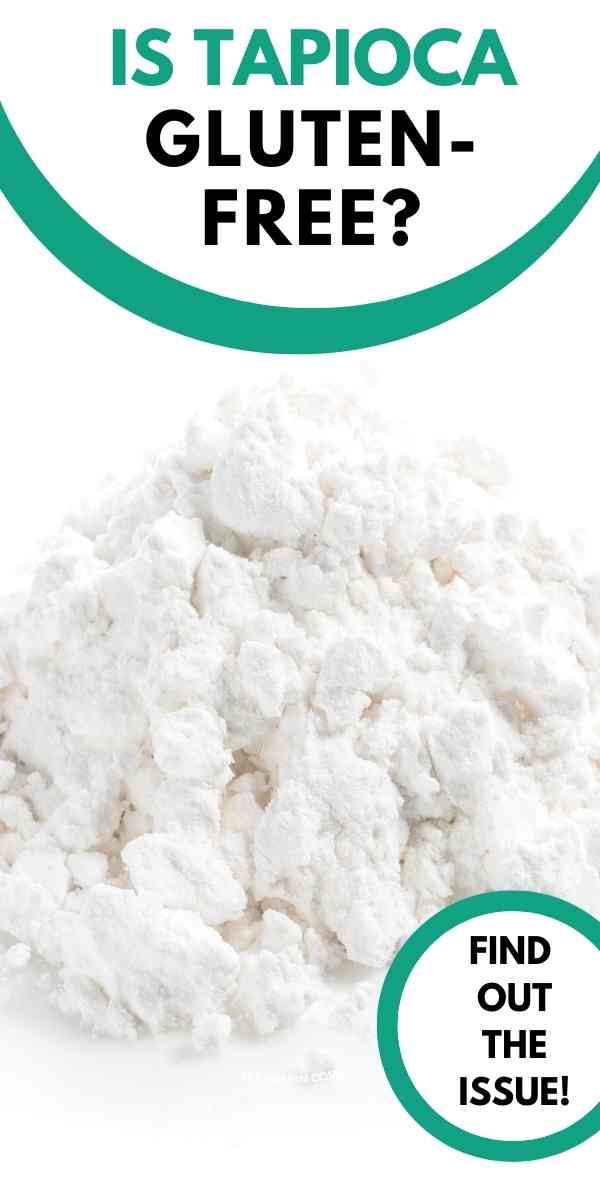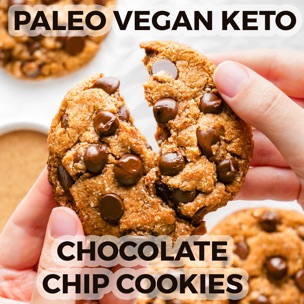Is tapioca gluten-free? The quick answer is yes, but keep reading to find out some issues that can come up. Included is a list of labeled and certified gluten-free tapioca products!
Tapioca is a starch derivative from the cassava tubular root and is naturally gluten-free, but that doesn’t always mean it’s safe for celiacs.
Tapioca is mostly pure carbs with very little protein, fiber or nutrients. It’s a dried product sold as white flour, flakes or pearls.
Tapioca flour or starch is often used in conjunction with other gluten-containing flours for making baked goods like this Gluten-free Banana Bread or these Soft and Chewy Gluten-free Cookies.
How is tapioca made?
It’s made by squeezing out ground cassava root’s starchy liquid.
Once the liquid has been evaporated, you’re left with a fine tapioca powder. It then gets processed into flakes or pearls.
The pearls are very popular and used in bubble tea and puddings and tapioca starch is often used in cooking sauces and soups.
It can also be used as a binding agent for making gluten-free and grain-free bread and flatbread. It’s pretty inexpensive and can be used in a variety of ways.
Be aware!
When you look for tapioca pearls or tapioca starch in general, you might want to buy a certified gluten-free product if you’re super sensitive to gluten.
A quick search for flavored tapioca pearls brought up all kinds of vividly colored and nicely packaged boba that would be enticing to most.
However, these were some of the ingredients: thickeners E142, preservatives with additional numbers, artificial flavorings and colors. And in some cases, “the presence of dyes that can affect attention in children.”
With all of these ingredients, it’s best to buy basic unflavored, tapioca pearls that are labeled gluten-free and flavor them to your liking. Plus, if you buy a certified gluten-free product and sweeten them yourself, you know exactly what is going into it.
I like mine sweetened with maple syrup, but there are many ways to naturally flavor tapioca pearls. This post shows you how to make them mango flavored, naturally.
Cross-contamination
Besides looking at artificial additives and flavorings, another main concern about purchasing products that are considered naturally gluten-free is cross-contamination.
This happens when you’re buying products that would generally be gluten-free but have been processed in the same facility as gluten-containing products.
The risk of cross-contamination is possible for all processed foods, so it’s best to search for labeled and certified products that meet your dietary needs.
So cross-contamination happens when foods come in contact with gluten from a different source in a shared facility. Gluten can be transferred by shared utensils, machinery or preparation surfaces, and in some cases the air.
Once gluten-free foods come in contact with other gluten ingredients, it’s no longer safe to eat if you are on a gluten-free diet.
Difference between certified and labeled gluten-free?
Certified gluten-free products are required to contain less than 10ppm of gluten. These products will have been tested and labeled as certified gluten-free, meaning they are safe for consumption on a gluten-free diet.
If you’re highly sensitive to gluten, you will want to search for the seal when you buy any product.
There are 5 different seals, and they all say GF or gluten-free certified. Here’s a look at all five.

Notice the last two belong to the same certification program. One is a newer label, the one on the right, and the older label in black and white. Older products may still have this seal but know that the products are certified gluten-free.
To be legally labeled as gluten-free in the US, they must meet strict requirements of the FDA as being less than 20ppm gluten. When products are tested under that amount, they can be labeled as such. 20ppm is considered safe for people with celiac disease.
Products that are naturally gluten-free are not always certified gluten-free, so keep that in mind when shopping around.
Like with organic certification, it costs companies a lot of money to become gluten-free certified. And it’s a yearly fee with rigorous testing, and some companies aren’t willing to go that extra mile, especially when something is naturally gluten-free. But it is important if you adhere to strict dietary restrictions to buy certified products.
If you are unable to find a certified gluten-free label on a naturally gluten-free product then research the facility or send an email to the manufacturer directly.
They will be able to tell you more if they have a dedicated facility which does not produce gluten-containing products in a shared facility.
Gluten-free tapioca
- Let’s Do Tapioca Granules – this is labeled kosher, non-GMO, vegan and certified gluten-free. The box says the granules are great for puddings, pies and more.
- Bob’s Red Mill Tapioca Flour (Tapioca Starch) – on their website, they say, “This gluten-free product was handled exclusively in our dedicated gluten-free facility and tested for gluten-free integrity in our quality control laboratory using an ELISA Gluten Assay test.” BUT! Note that their Small Pearl Tapioca is NOT labeled as gluten-free. That product is described as vegan, paleo-friendly, non-GMO and kosher on their website. But there is no gluten-free label on the product.
- Ener-G Tapioca Flour – on their Allergen Statement, they write, “Ener-G Foods’ facilities are dedicated wheat-free, gluten-free, dairy-free, peanut free, tree-nut free, soy free, and kosher certified.” So you can buy anything from them without worry! It’s also labeled as vegan.
- Nuts.com (several tapioca products) – they have both gluten-free labeled and certified gluten-free products. You can read more about that here. Their tapioca flour is certified gluten-free, but note that their Large Pearl Tapioca is processed “in the same facility as peanuts, tree nuts, wheat, soy, and milk products.” So you really need to check out each product to see which one will work for you. For me, processed in the same facility is okay. For celiacs and many other people very sensitive to gluten, it is definitely not okay!
- NOW Tapioca Flour – this one is labeled as gluten-free. One site I read said that ALL the NOW baking ingredients are certified gluten-free, but according to NOW’s website, only three products are – and that doesn’t include the tapioca flour.
- Iya Foods Tapioca Starch – this is certified gluten-free, non-GMO and kosher. It’s also a great price!
I hope now you have all the information needed to make the best choice for your dietary needs. If you have other questions, please leave a comment, and I’ll be happy to help.


